Gender and Organizational Dynamics
VerifiedAdded on 2020/05/16
|10
|3175
|150
AI Summary
This assignment explores the complex relationship between gender and organizational structures and practices. It delves into topics such as changing employment practices, gender perceptions in work-life balance, social class differences at work, and the challenges of achieving workforce diversity. The analysis draws upon relevant academic research to shed light on gender inequality in the workplace, including issues like pay gaps and resistance to gender training.
Contribute Materials
Your contribution can guide someone’s learning journey. Share your
documents today.
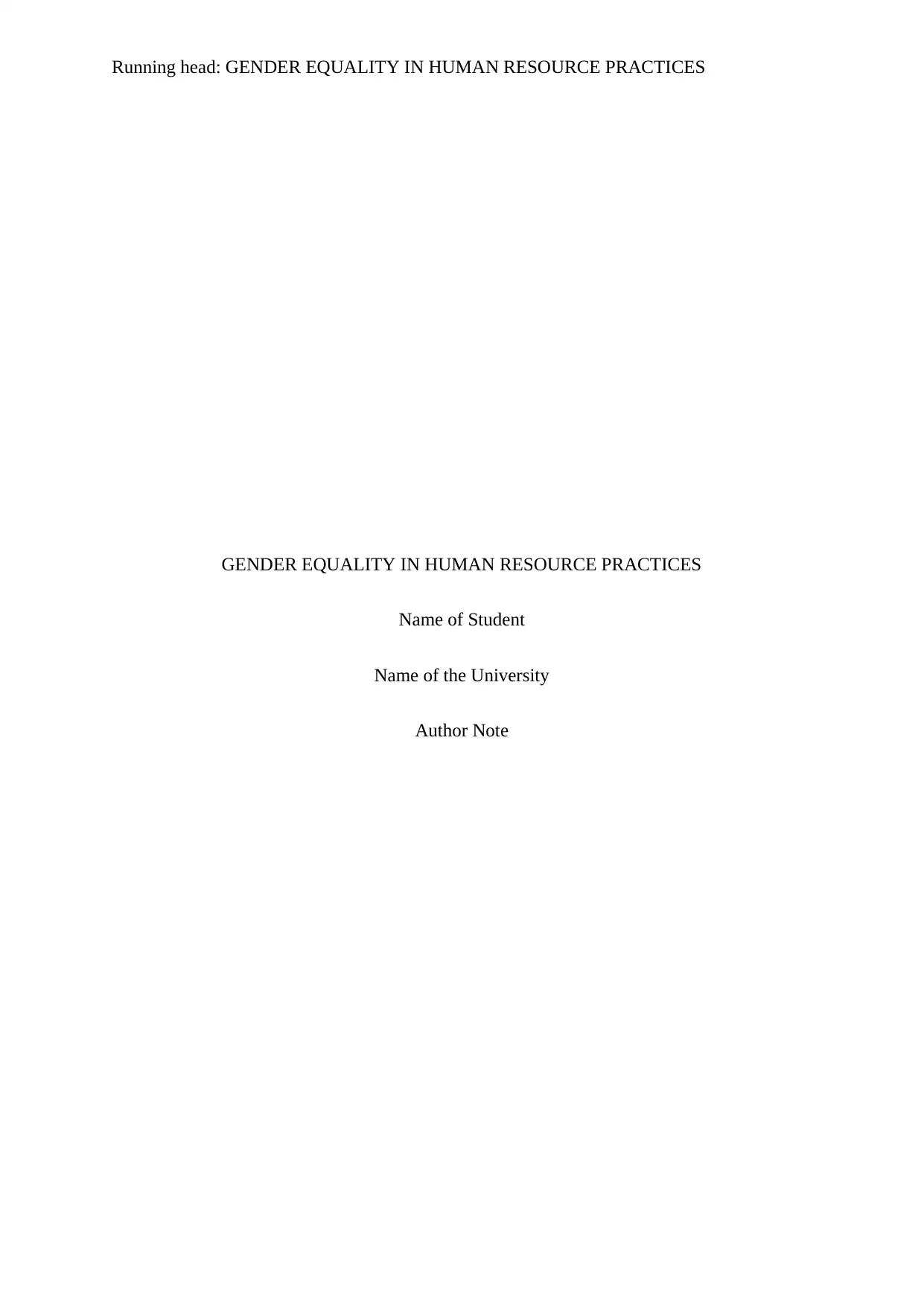
Running head: GENDER EQUALITY IN HUMAN RESOURCE PRACTICES
GENDER EQUALITY IN HUMAN RESOURCE PRACTICES
Name of Student
Name of the University
Author Note
GENDER EQUALITY IN HUMAN RESOURCE PRACTICES
Name of Student
Name of the University
Author Note
Secure Best Marks with AI Grader
Need help grading? Try our AI Grader for instant feedback on your assignments.
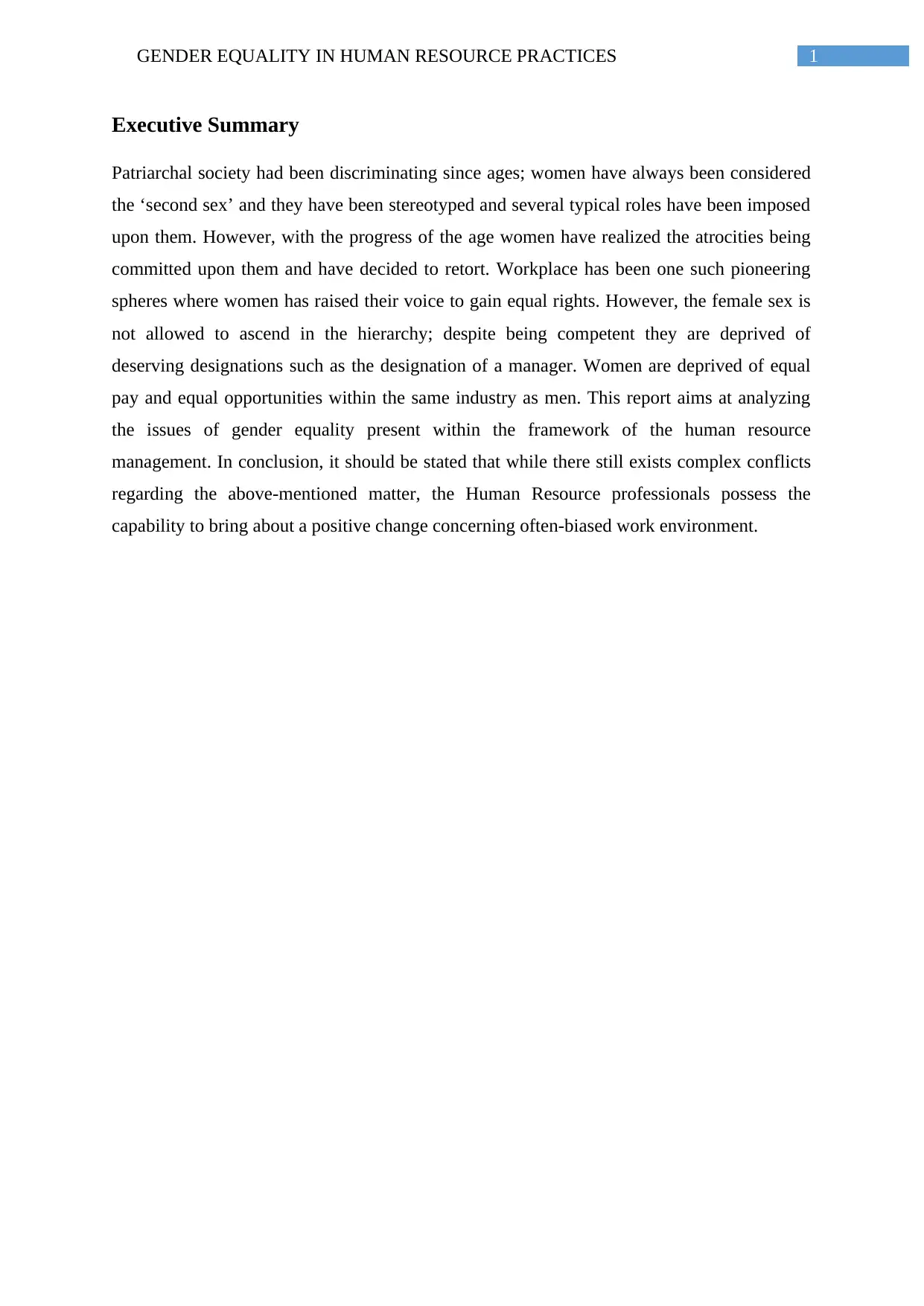
1GENDER EQUALITY IN HUMAN RESOURCE PRACTICES
Executive Summary
Patriarchal society had been discriminating since ages; women have always been considered
the ‘second sex’ and they have been stereotyped and several typical roles have been imposed
upon them. However, with the progress of the age women have realized the atrocities being
committed upon them and have decided to retort. Workplace has been one such pioneering
spheres where women has raised their voice to gain equal rights. However, the female sex is
not allowed to ascend in the hierarchy; despite being competent they are deprived of
deserving designations such as the designation of a manager. Women are deprived of equal
pay and equal opportunities within the same industry as men. This report aims at analyzing
the issues of gender equality present within the framework of the human resource
management. In conclusion, it should be stated that while there still exists complex conflicts
regarding the above-mentioned matter, the Human Resource professionals possess the
capability to bring about a positive change concerning often-biased work environment.
Executive Summary
Patriarchal society had been discriminating since ages; women have always been considered
the ‘second sex’ and they have been stereotyped and several typical roles have been imposed
upon them. However, with the progress of the age women have realized the atrocities being
committed upon them and have decided to retort. Workplace has been one such pioneering
spheres where women has raised their voice to gain equal rights. However, the female sex is
not allowed to ascend in the hierarchy; despite being competent they are deprived of
deserving designations such as the designation of a manager. Women are deprived of equal
pay and equal opportunities within the same industry as men. This report aims at analyzing
the issues of gender equality present within the framework of the human resource
management. In conclusion, it should be stated that while there still exists complex conflicts
regarding the above-mentioned matter, the Human Resource professionals possess the
capability to bring about a positive change concerning often-biased work environment.
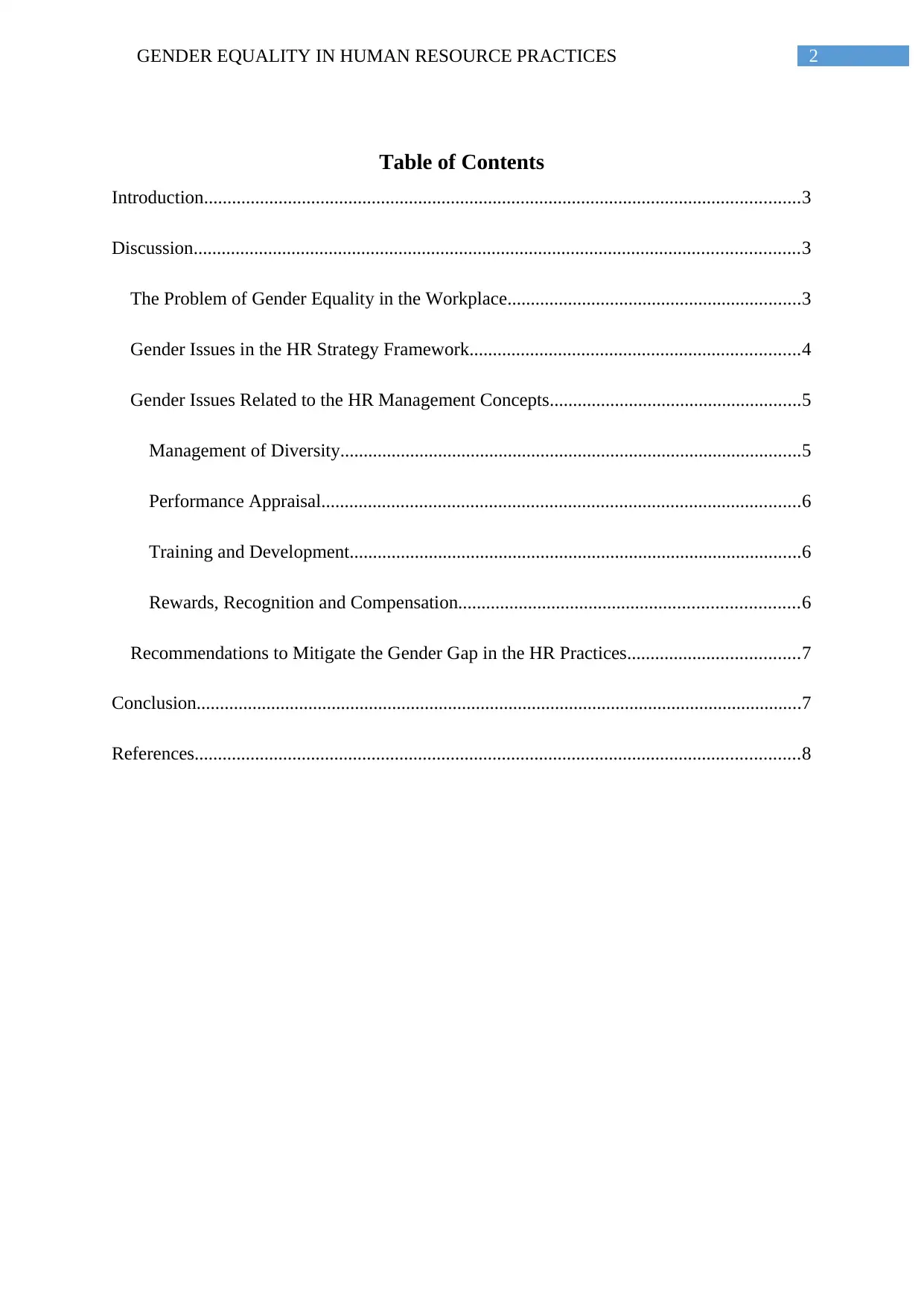
2GENDER EQUALITY IN HUMAN RESOURCE PRACTICES
Table of Contents
Introduction................................................................................................................................3
Discussion..................................................................................................................................3
The Problem of Gender Equality in the Workplace...............................................................3
Gender Issues in the HR Strategy Framework.......................................................................4
Gender Issues Related to the HR Management Concepts......................................................5
Management of Diversity...................................................................................................5
Performance Appraisal.......................................................................................................6
Training and Development.................................................................................................6
Rewards, Recognition and Compensation.........................................................................6
Recommendations to Mitigate the Gender Gap in the HR Practices.....................................7
Conclusion..................................................................................................................................7
References..................................................................................................................................8
Table of Contents
Introduction................................................................................................................................3
Discussion..................................................................................................................................3
The Problem of Gender Equality in the Workplace...............................................................3
Gender Issues in the HR Strategy Framework.......................................................................4
Gender Issues Related to the HR Management Concepts......................................................5
Management of Diversity...................................................................................................5
Performance Appraisal.......................................................................................................6
Training and Development.................................................................................................6
Rewards, Recognition and Compensation.........................................................................6
Recommendations to Mitigate the Gender Gap in the HR Practices.....................................7
Conclusion..................................................................................................................................7
References..................................................................................................................................8
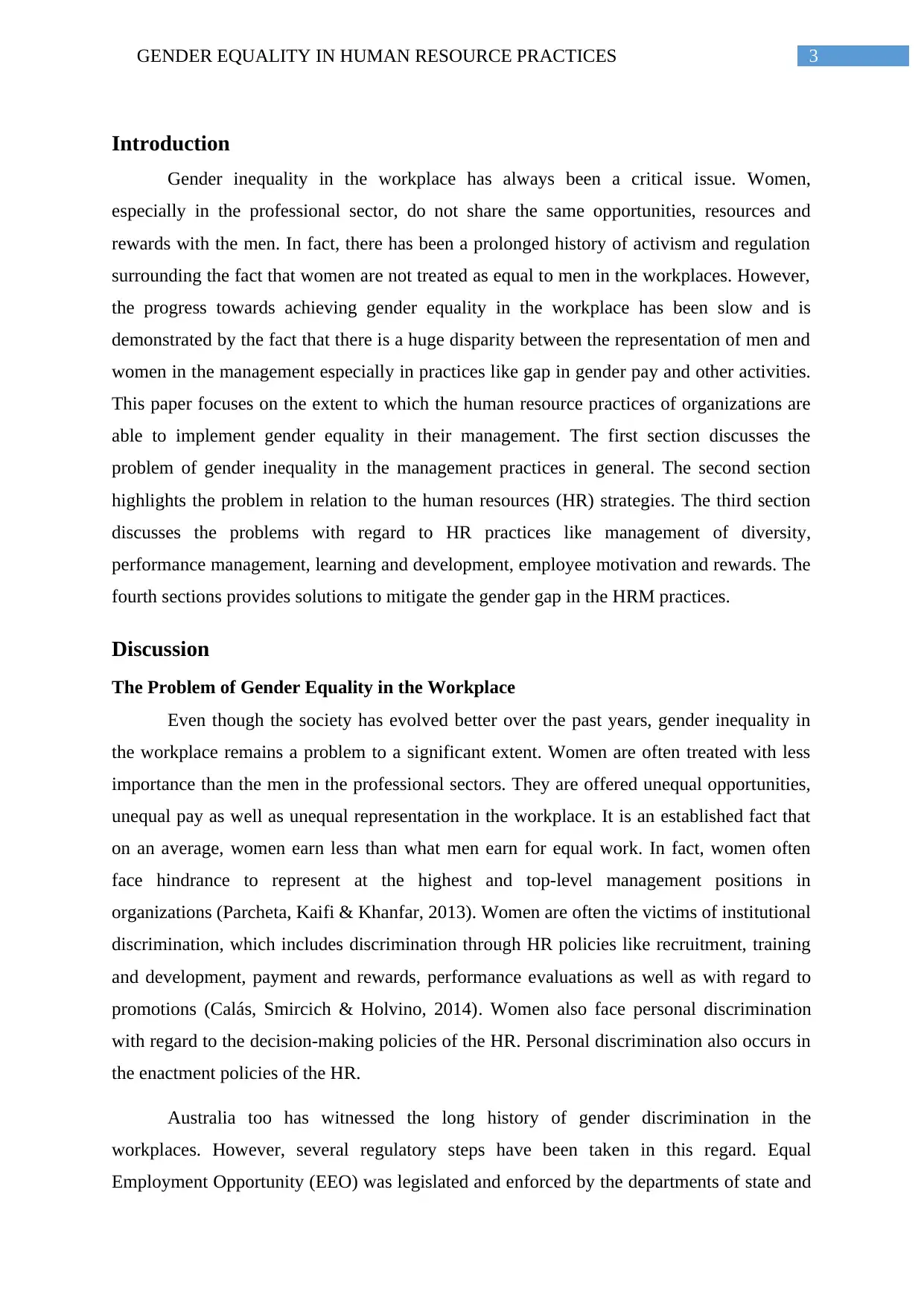
3GENDER EQUALITY IN HUMAN RESOURCE PRACTICES
Introduction
Gender inequality in the workplace has always been a critical issue. Women,
especially in the professional sector, do not share the same opportunities, resources and
rewards with the men. In fact, there has been a prolonged history of activism and regulation
surrounding the fact that women are not treated as equal to men in the workplaces. However,
the progress towards achieving gender equality in the workplace has been slow and is
demonstrated by the fact that there is a huge disparity between the representation of men and
women in the management especially in practices like gap in gender pay and other activities.
This paper focuses on the extent to which the human resource practices of organizations are
able to implement gender equality in their management. The first section discusses the
problem of gender inequality in the management practices in general. The second section
highlights the problem in relation to the human resources (HR) strategies. The third section
discusses the problems with regard to HR practices like management of diversity,
performance management, learning and development, employee motivation and rewards. The
fourth sections provides solutions to mitigate the gender gap in the HRM practices.
Discussion
The Problem of Gender Equality in the Workplace
Even though the society has evolved better over the past years, gender inequality in
the workplace remains a problem to a significant extent. Women are often treated with less
importance than the men in the professional sectors. They are offered unequal opportunities,
unequal pay as well as unequal representation in the workplace. It is an established fact that
on an average, women earn less than what men earn for equal work. In fact, women often
face hindrance to represent at the highest and top-level management positions in
organizations (Parcheta, Kaifi & Khanfar, 2013). Women are often the victims of institutional
discrimination, which includes discrimination through HR policies like recruitment, training
and development, payment and rewards, performance evaluations as well as with regard to
promotions (Calás, Smircich & Holvino, 2014). Women also face personal discrimination
with regard to the decision-making policies of the HR. Personal discrimination also occurs in
the enactment policies of the HR.
Australia too has witnessed the long history of gender discrimination in the
workplaces. However, several regulatory steps have been taken in this regard. Equal
Employment Opportunity (EEO) was legislated and enforced by the departments of state and
Introduction
Gender inequality in the workplace has always been a critical issue. Women,
especially in the professional sector, do not share the same opportunities, resources and
rewards with the men. In fact, there has been a prolonged history of activism and regulation
surrounding the fact that women are not treated as equal to men in the workplaces. However,
the progress towards achieving gender equality in the workplace has been slow and is
demonstrated by the fact that there is a huge disparity between the representation of men and
women in the management especially in practices like gap in gender pay and other activities.
This paper focuses on the extent to which the human resource practices of organizations are
able to implement gender equality in their management. The first section discusses the
problem of gender inequality in the management practices in general. The second section
highlights the problem in relation to the human resources (HR) strategies. The third section
discusses the problems with regard to HR practices like management of diversity,
performance management, learning and development, employee motivation and rewards. The
fourth sections provides solutions to mitigate the gender gap in the HRM practices.
Discussion
The Problem of Gender Equality in the Workplace
Even though the society has evolved better over the past years, gender inequality in
the workplace remains a problem to a significant extent. Women are often treated with less
importance than the men in the professional sectors. They are offered unequal opportunities,
unequal pay as well as unequal representation in the workplace. It is an established fact that
on an average, women earn less than what men earn for equal work. In fact, women often
face hindrance to represent at the highest and top-level management positions in
organizations (Parcheta, Kaifi & Khanfar, 2013). Women are often the victims of institutional
discrimination, which includes discrimination through HR policies like recruitment, training
and development, payment and rewards, performance evaluations as well as with regard to
promotions (Calás, Smircich & Holvino, 2014). Women also face personal discrimination
with regard to the decision-making policies of the HR. Personal discrimination also occurs in
the enactment policies of the HR.
Australia too has witnessed the long history of gender discrimination in the
workplaces. However, several regulatory steps have been taken in this regard. Equal
Employment Opportunity (EEO) was legislated and enforced by the departments of state and
Secure Best Marks with AI Grader
Need help grading? Try our AI Grader for instant feedback on your assignments.
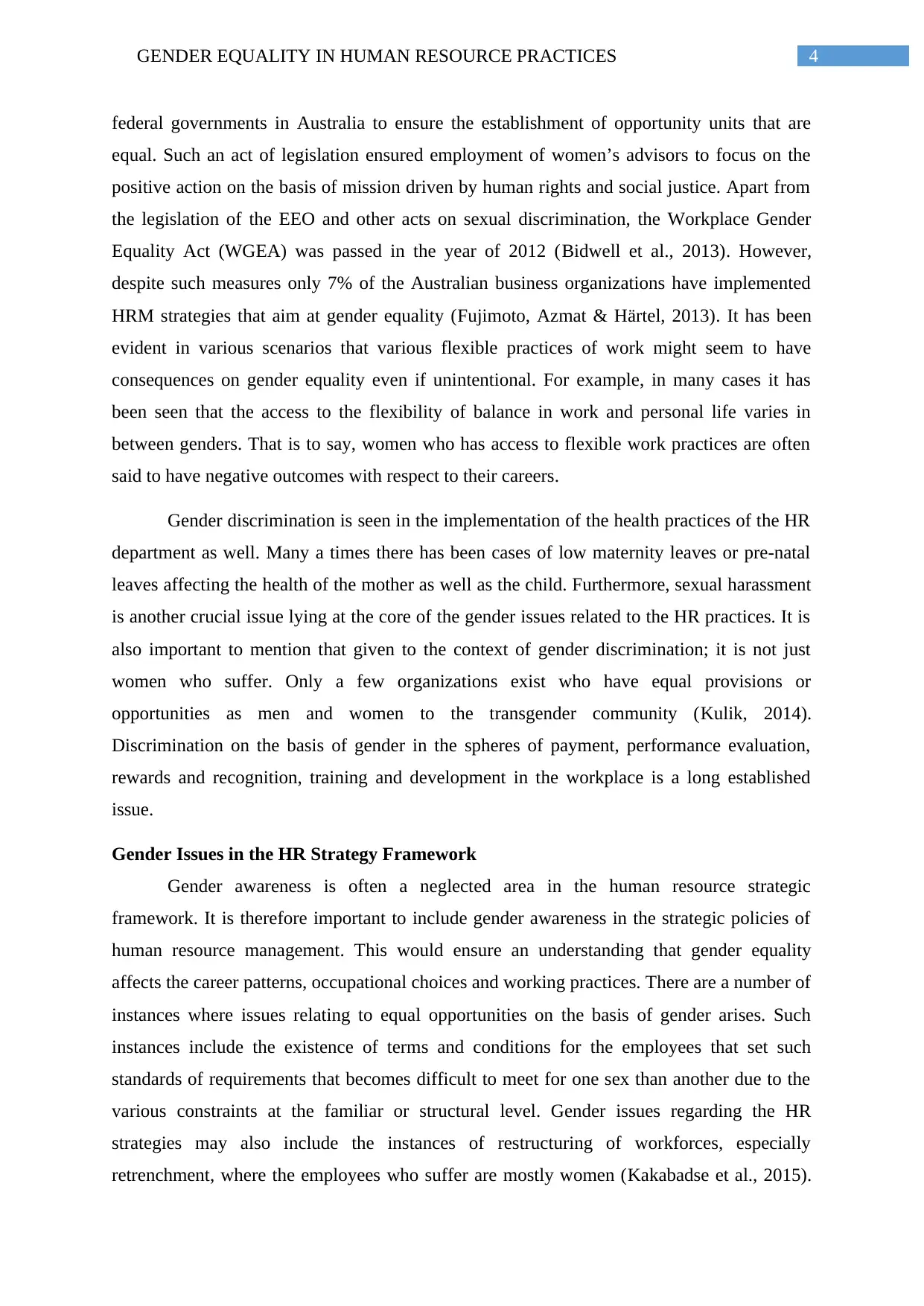
4GENDER EQUALITY IN HUMAN RESOURCE PRACTICES
federal governments in Australia to ensure the establishment of opportunity units that are
equal. Such an act of legislation ensured employment of women’s advisors to focus on the
positive action on the basis of mission driven by human rights and social justice. Apart from
the legislation of the EEO and other acts on sexual discrimination, the Workplace Gender
Equality Act (WGEA) was passed in the year of 2012 (Bidwell et al., 2013). However,
despite such measures only 7% of the Australian business organizations have implemented
HRM strategies that aim at gender equality (Fujimoto, Azmat & Härtel, 2013). It has been
evident in various scenarios that various flexible practices of work might seem to have
consequences on gender equality even if unintentional. For example, in many cases it has
been seen that the access to the flexibility of balance in work and personal life varies in
between genders. That is to say, women who has access to flexible work practices are often
said to have negative outcomes with respect to their careers.
Gender discrimination is seen in the implementation of the health practices of the HR
department as well. Many a times there has been cases of low maternity leaves or pre-natal
leaves affecting the health of the mother as well as the child. Furthermore, sexual harassment
is another crucial issue lying at the core of the gender issues related to the HR practices. It is
also important to mention that given to the context of gender discrimination; it is not just
women who suffer. Only a few organizations exist who have equal provisions or
opportunities as men and women to the transgender community (Kulik, 2014).
Discrimination on the basis of gender in the spheres of payment, performance evaluation,
rewards and recognition, training and development in the workplace is a long established
issue.
Gender Issues in the HR Strategy Framework
Gender awareness is often a neglected area in the human resource strategic
framework. It is therefore important to include gender awareness in the strategic policies of
human resource management. This would ensure an understanding that gender equality
affects the career patterns, occupational choices and working practices. There are a number of
instances where issues relating to equal opportunities on the basis of gender arises. Such
instances include the existence of terms and conditions for the employees that set such
standards of requirements that becomes difficult to meet for one sex than another due to the
various constraints at the familiar or structural level. Gender issues regarding the HR
strategies may also include the instances of restructuring of workforces, especially
retrenchment, where the employees who suffer are mostly women (Kakabadse et al., 2015).
federal governments in Australia to ensure the establishment of opportunity units that are
equal. Such an act of legislation ensured employment of women’s advisors to focus on the
positive action on the basis of mission driven by human rights and social justice. Apart from
the legislation of the EEO and other acts on sexual discrimination, the Workplace Gender
Equality Act (WGEA) was passed in the year of 2012 (Bidwell et al., 2013). However,
despite such measures only 7% of the Australian business organizations have implemented
HRM strategies that aim at gender equality (Fujimoto, Azmat & Härtel, 2013). It has been
evident in various scenarios that various flexible practices of work might seem to have
consequences on gender equality even if unintentional. For example, in many cases it has
been seen that the access to the flexibility of balance in work and personal life varies in
between genders. That is to say, women who has access to flexible work practices are often
said to have negative outcomes with respect to their careers.
Gender discrimination is seen in the implementation of the health practices of the HR
department as well. Many a times there has been cases of low maternity leaves or pre-natal
leaves affecting the health of the mother as well as the child. Furthermore, sexual harassment
is another crucial issue lying at the core of the gender issues related to the HR practices. It is
also important to mention that given to the context of gender discrimination; it is not just
women who suffer. Only a few organizations exist who have equal provisions or
opportunities as men and women to the transgender community (Kulik, 2014).
Discrimination on the basis of gender in the spheres of payment, performance evaluation,
rewards and recognition, training and development in the workplace is a long established
issue.
Gender Issues in the HR Strategy Framework
Gender awareness is often a neglected area in the human resource strategic
framework. It is therefore important to include gender awareness in the strategic policies of
human resource management. This would ensure an understanding that gender equality
affects the career patterns, occupational choices and working practices. There are a number of
instances where issues relating to equal opportunities on the basis of gender arises. Such
instances include the existence of terms and conditions for the employees that set such
standards of requirements that becomes difficult to meet for one sex than another due to the
various constraints at the familiar or structural level. Gender issues regarding the HR
strategies may also include the instances of restructuring of workforces, especially
retrenchment, where the employees who suffer are mostly women (Kakabadse et al., 2015).
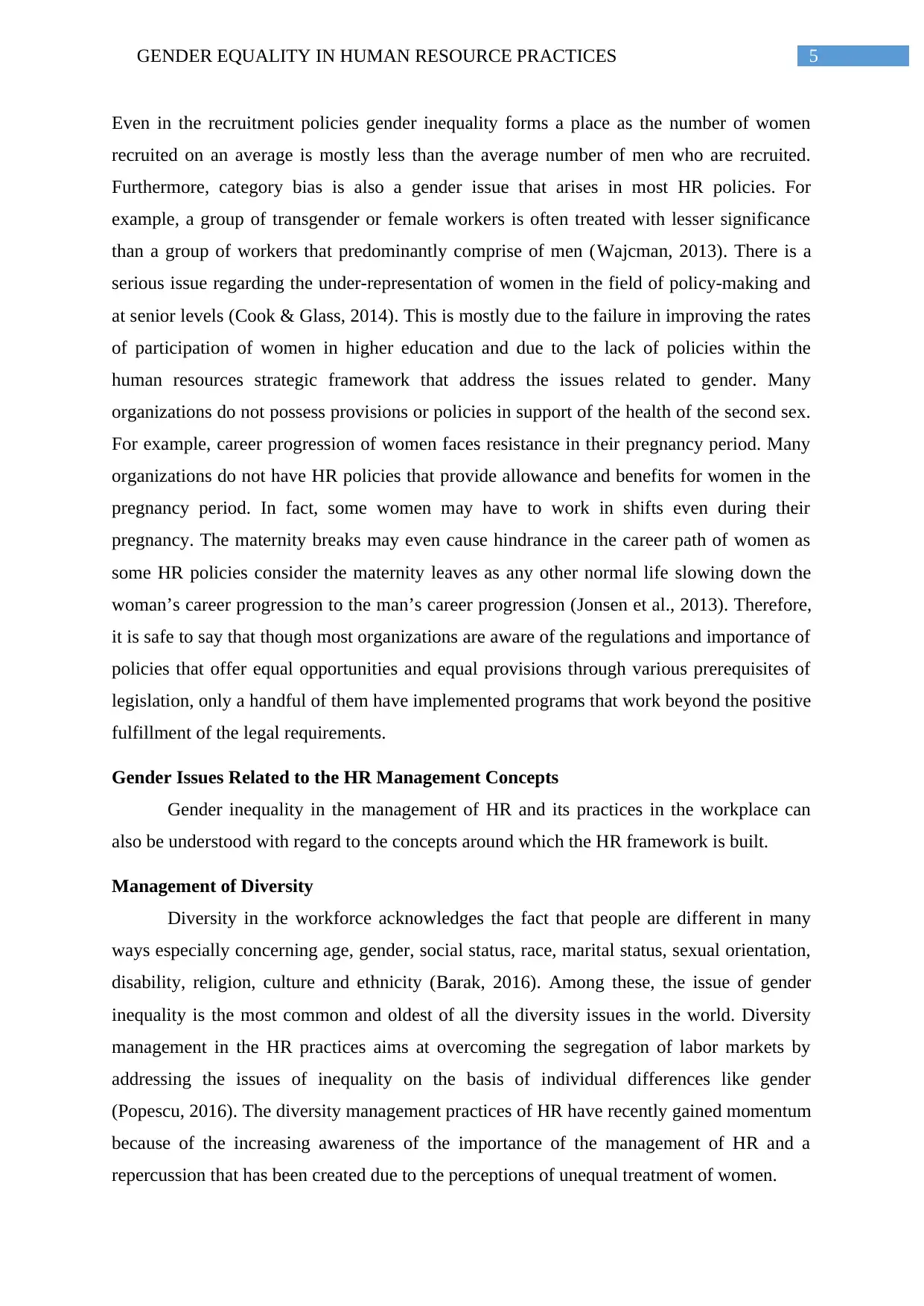
5GENDER EQUALITY IN HUMAN RESOURCE PRACTICES
Even in the recruitment policies gender inequality forms a place as the number of women
recruited on an average is mostly less than the average number of men who are recruited.
Furthermore, category bias is also a gender issue that arises in most HR policies. For
example, a group of transgender or female workers is often treated with lesser significance
than a group of workers that predominantly comprise of men (Wajcman, 2013). There is a
serious issue regarding the under-representation of women in the field of policy-making and
at senior levels (Cook & Glass, 2014). This is mostly due to the failure in improving the rates
of participation of women in higher education and due to the lack of policies within the
human resources strategic framework that address the issues related to gender. Many
organizations do not possess provisions or policies in support of the health of the second sex.
For example, career progression of women faces resistance in their pregnancy period. Many
organizations do not have HR policies that provide allowance and benefits for women in the
pregnancy period. In fact, some women may have to work in shifts even during their
pregnancy. The maternity breaks may even cause hindrance in the career path of women as
some HR policies consider the maternity leaves as any other normal life slowing down the
woman’s career progression to the man’s career progression (Jonsen et al., 2013). Therefore,
it is safe to say that though most organizations are aware of the regulations and importance of
policies that offer equal opportunities and equal provisions through various prerequisites of
legislation, only a handful of them have implemented programs that work beyond the positive
fulfillment of the legal requirements.
Gender Issues Related to the HR Management Concepts
Gender inequality in the management of HR and its practices in the workplace can
also be understood with regard to the concepts around which the HR framework is built.
Management of Diversity
Diversity in the workforce acknowledges the fact that people are different in many
ways especially concerning age, gender, social status, race, marital status, sexual orientation,
disability, religion, culture and ethnicity (Barak, 2016). Among these, the issue of gender
inequality is the most common and oldest of all the diversity issues in the world. Diversity
management in the HR practices aims at overcoming the segregation of labor markets by
addressing the issues of inequality on the basis of individual differences like gender
(Popescu, 2016). The diversity management practices of HR have recently gained momentum
because of the increasing awareness of the importance of the management of HR and a
repercussion that has been created due to the perceptions of unequal treatment of women.
Even in the recruitment policies gender inequality forms a place as the number of women
recruited on an average is mostly less than the average number of men who are recruited.
Furthermore, category bias is also a gender issue that arises in most HR policies. For
example, a group of transgender or female workers is often treated with lesser significance
than a group of workers that predominantly comprise of men (Wajcman, 2013). There is a
serious issue regarding the under-representation of women in the field of policy-making and
at senior levels (Cook & Glass, 2014). This is mostly due to the failure in improving the rates
of participation of women in higher education and due to the lack of policies within the
human resources strategic framework that address the issues related to gender. Many
organizations do not possess provisions or policies in support of the health of the second sex.
For example, career progression of women faces resistance in their pregnancy period. Many
organizations do not have HR policies that provide allowance and benefits for women in the
pregnancy period. In fact, some women may have to work in shifts even during their
pregnancy. The maternity breaks may even cause hindrance in the career path of women as
some HR policies consider the maternity leaves as any other normal life slowing down the
woman’s career progression to the man’s career progression (Jonsen et al., 2013). Therefore,
it is safe to say that though most organizations are aware of the regulations and importance of
policies that offer equal opportunities and equal provisions through various prerequisites of
legislation, only a handful of them have implemented programs that work beyond the positive
fulfillment of the legal requirements.
Gender Issues Related to the HR Management Concepts
Gender inequality in the management of HR and its practices in the workplace can
also be understood with regard to the concepts around which the HR framework is built.
Management of Diversity
Diversity in the workforce acknowledges the fact that people are different in many
ways especially concerning age, gender, social status, race, marital status, sexual orientation,
disability, religion, culture and ethnicity (Barak, 2016). Among these, the issue of gender
inequality is the most common and oldest of all the diversity issues in the world. Diversity
management in the HR practices aims at overcoming the segregation of labor markets by
addressing the issues of inequality on the basis of individual differences like gender
(Popescu, 2016). The diversity management practices of HR have recently gained momentum
because of the increasing awareness of the importance of the management of HR and a
repercussion that has been created due to the perceptions of unequal treatment of women.
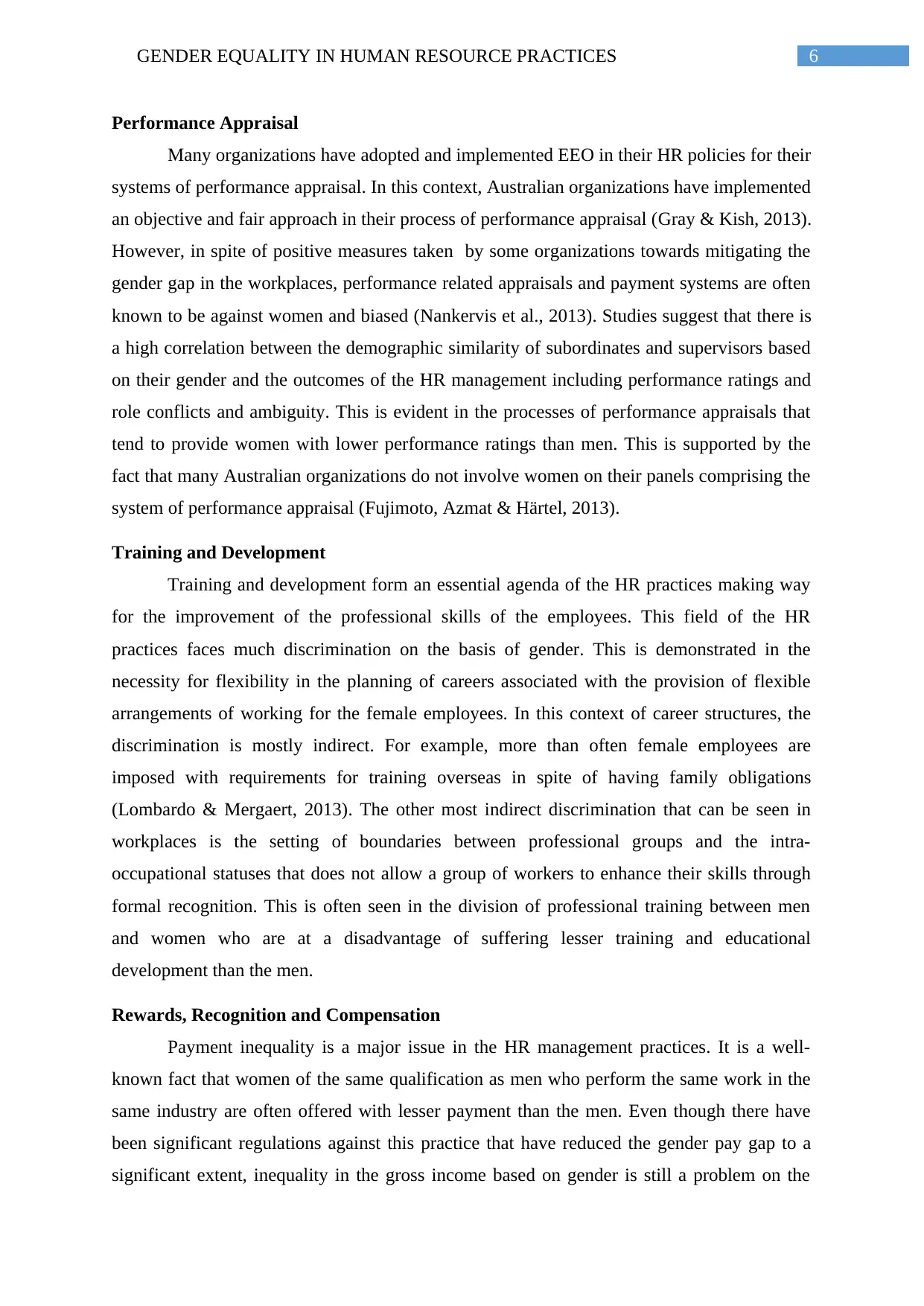
6GENDER EQUALITY IN HUMAN RESOURCE PRACTICES
Performance Appraisal
Many organizations have adopted and implemented EEO in their HR policies for their
systems of performance appraisal. In this context, Australian organizations have implemented
an objective and fair approach in their process of performance appraisal (Gray & Kish, 2013).
However, in spite of positive measures taken by some organizations towards mitigating the
gender gap in the workplaces, performance related appraisals and payment systems are often
known to be against women and biased (Nankervis et al., 2013). Studies suggest that there is
a high correlation between the demographic similarity of subordinates and supervisors based
on their gender and the outcomes of the HR management including performance ratings and
role conflicts and ambiguity. This is evident in the processes of performance appraisals that
tend to provide women with lower performance ratings than men. This is supported by the
fact that many Australian organizations do not involve women on their panels comprising the
system of performance appraisal (Fujimoto, Azmat & Härtel, 2013).
Training and Development
Training and development form an essential agenda of the HR practices making way
for the improvement of the professional skills of the employees. This field of the HR
practices faces much discrimination on the basis of gender. This is demonstrated in the
necessity for flexibility in the planning of careers associated with the provision of flexible
arrangements of working for the female employees. In this context of career structures, the
discrimination is mostly indirect. For example, more than often female employees are
imposed with requirements for training overseas in spite of having family obligations
(Lombardo & Mergaert, 2013). The other most indirect discrimination that can be seen in
workplaces is the setting of boundaries between professional groups and the intra-
occupational statuses that does not allow a group of workers to enhance their skills through
formal recognition. This is often seen in the division of professional training between men
and women who are at a disadvantage of suffering lesser training and educational
development than the men.
Rewards, Recognition and Compensation
Payment inequality is a major issue in the HR management practices. It is a well-
known fact that women of the same qualification as men who perform the same work in the
same industry are often offered with lesser payment than the men. Even though there have
been significant regulations against this practice that have reduced the gender pay gap to a
significant extent, inequality in the gross income based on gender is still a problem on the
Performance Appraisal
Many organizations have adopted and implemented EEO in their HR policies for their
systems of performance appraisal. In this context, Australian organizations have implemented
an objective and fair approach in their process of performance appraisal (Gray & Kish, 2013).
However, in spite of positive measures taken by some organizations towards mitigating the
gender gap in the workplaces, performance related appraisals and payment systems are often
known to be against women and biased (Nankervis et al., 2013). Studies suggest that there is
a high correlation between the demographic similarity of subordinates and supervisors based
on their gender and the outcomes of the HR management including performance ratings and
role conflicts and ambiguity. This is evident in the processes of performance appraisals that
tend to provide women with lower performance ratings than men. This is supported by the
fact that many Australian organizations do not involve women on their panels comprising the
system of performance appraisal (Fujimoto, Azmat & Härtel, 2013).
Training and Development
Training and development form an essential agenda of the HR practices making way
for the improvement of the professional skills of the employees. This field of the HR
practices faces much discrimination on the basis of gender. This is demonstrated in the
necessity for flexibility in the planning of careers associated with the provision of flexible
arrangements of working for the female employees. In this context of career structures, the
discrimination is mostly indirect. For example, more than often female employees are
imposed with requirements for training overseas in spite of having family obligations
(Lombardo & Mergaert, 2013). The other most indirect discrimination that can be seen in
workplaces is the setting of boundaries between professional groups and the intra-
occupational statuses that does not allow a group of workers to enhance their skills through
formal recognition. This is often seen in the division of professional training between men
and women who are at a disadvantage of suffering lesser training and educational
development than the men.
Rewards, Recognition and Compensation
Payment inequality is a major issue in the HR management practices. It is a well-
known fact that women of the same qualification as men who perform the same work in the
same industry are often offered with lesser payment than the men. Even though there have
been significant regulations against this practice that have reduced the gender pay gap to a
significant extent, inequality in the gross income based on gender is still a problem on the
Paraphrase This Document
Need a fresh take? Get an instant paraphrase of this document with our AI Paraphraser
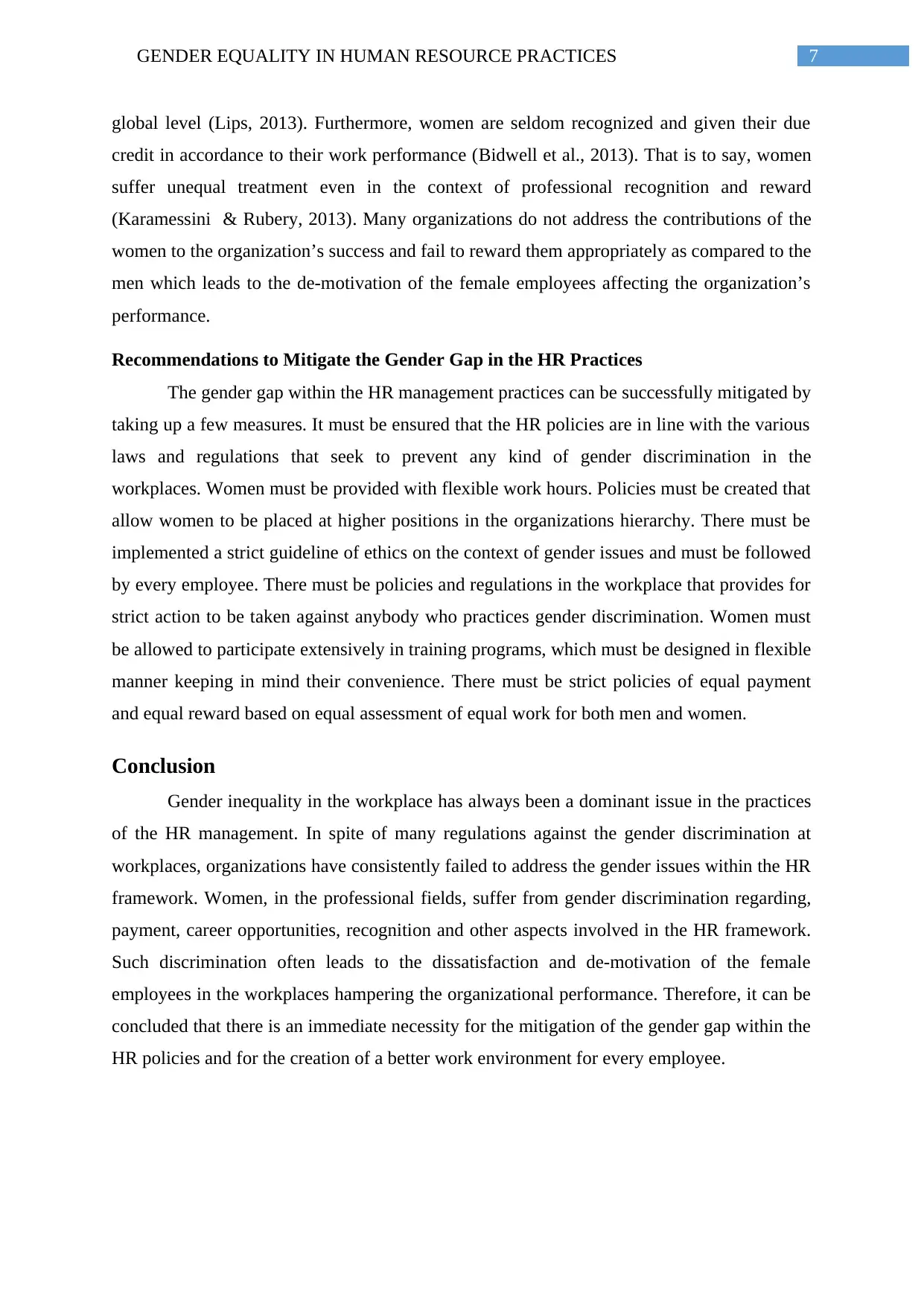
7GENDER EQUALITY IN HUMAN RESOURCE PRACTICES
global level (Lips, 2013). Furthermore, women are seldom recognized and given their due
credit in accordance to their work performance (Bidwell et al., 2013). That is to say, women
suffer unequal treatment even in the context of professional recognition and reward
(Karamessini & Rubery, 2013). Many organizations do not address the contributions of the
women to the organization’s success and fail to reward them appropriately as compared to the
men which leads to the de-motivation of the female employees affecting the organization’s
performance.
Recommendations to Mitigate the Gender Gap in the HR Practices
The gender gap within the HR management practices can be successfully mitigated by
taking up a few measures. It must be ensured that the HR policies are in line with the various
laws and regulations that seek to prevent any kind of gender discrimination in the
workplaces. Women must be provided with flexible work hours. Policies must be created that
allow women to be placed at higher positions in the organizations hierarchy. There must be
implemented a strict guideline of ethics on the context of gender issues and must be followed
by every employee. There must be policies and regulations in the workplace that provides for
strict action to be taken against anybody who practices gender discrimination. Women must
be allowed to participate extensively in training programs, which must be designed in flexible
manner keeping in mind their convenience. There must be strict policies of equal payment
and equal reward based on equal assessment of equal work for both men and women.
Conclusion
Gender inequality in the workplace has always been a dominant issue in the practices
of the HR management. In spite of many regulations against the gender discrimination at
workplaces, organizations have consistently failed to address the gender issues within the HR
framework. Women, in the professional fields, suffer from gender discrimination regarding,
payment, career opportunities, recognition and other aspects involved in the HR framework.
Such discrimination often leads to the dissatisfaction and de-motivation of the female
employees in the workplaces hampering the organizational performance. Therefore, it can be
concluded that there is an immediate necessity for the mitigation of the gender gap within the
HR policies and for the creation of a better work environment for every employee.
global level (Lips, 2013). Furthermore, women are seldom recognized and given their due
credit in accordance to their work performance (Bidwell et al., 2013). That is to say, women
suffer unequal treatment even in the context of professional recognition and reward
(Karamessini & Rubery, 2013). Many organizations do not address the contributions of the
women to the organization’s success and fail to reward them appropriately as compared to the
men which leads to the de-motivation of the female employees affecting the organization’s
performance.
Recommendations to Mitigate the Gender Gap in the HR Practices
The gender gap within the HR management practices can be successfully mitigated by
taking up a few measures. It must be ensured that the HR policies are in line with the various
laws and regulations that seek to prevent any kind of gender discrimination in the
workplaces. Women must be provided with flexible work hours. Policies must be created that
allow women to be placed at higher positions in the organizations hierarchy. There must be
implemented a strict guideline of ethics on the context of gender issues and must be followed
by every employee. There must be policies and regulations in the workplace that provides for
strict action to be taken against anybody who practices gender discrimination. Women must
be allowed to participate extensively in training programs, which must be designed in flexible
manner keeping in mind their convenience. There must be strict policies of equal payment
and equal reward based on equal assessment of equal work for both men and women.
Conclusion
Gender inequality in the workplace has always been a dominant issue in the practices
of the HR management. In spite of many regulations against the gender discrimination at
workplaces, organizations have consistently failed to address the gender issues within the HR
framework. Women, in the professional fields, suffer from gender discrimination regarding,
payment, career opportunities, recognition and other aspects involved in the HR framework.
Such discrimination often leads to the dissatisfaction and de-motivation of the female
employees in the workplaces hampering the organizational performance. Therefore, it can be
concluded that there is an immediate necessity for the mitigation of the gender gap within the
HR policies and for the creation of a better work environment for every employee.
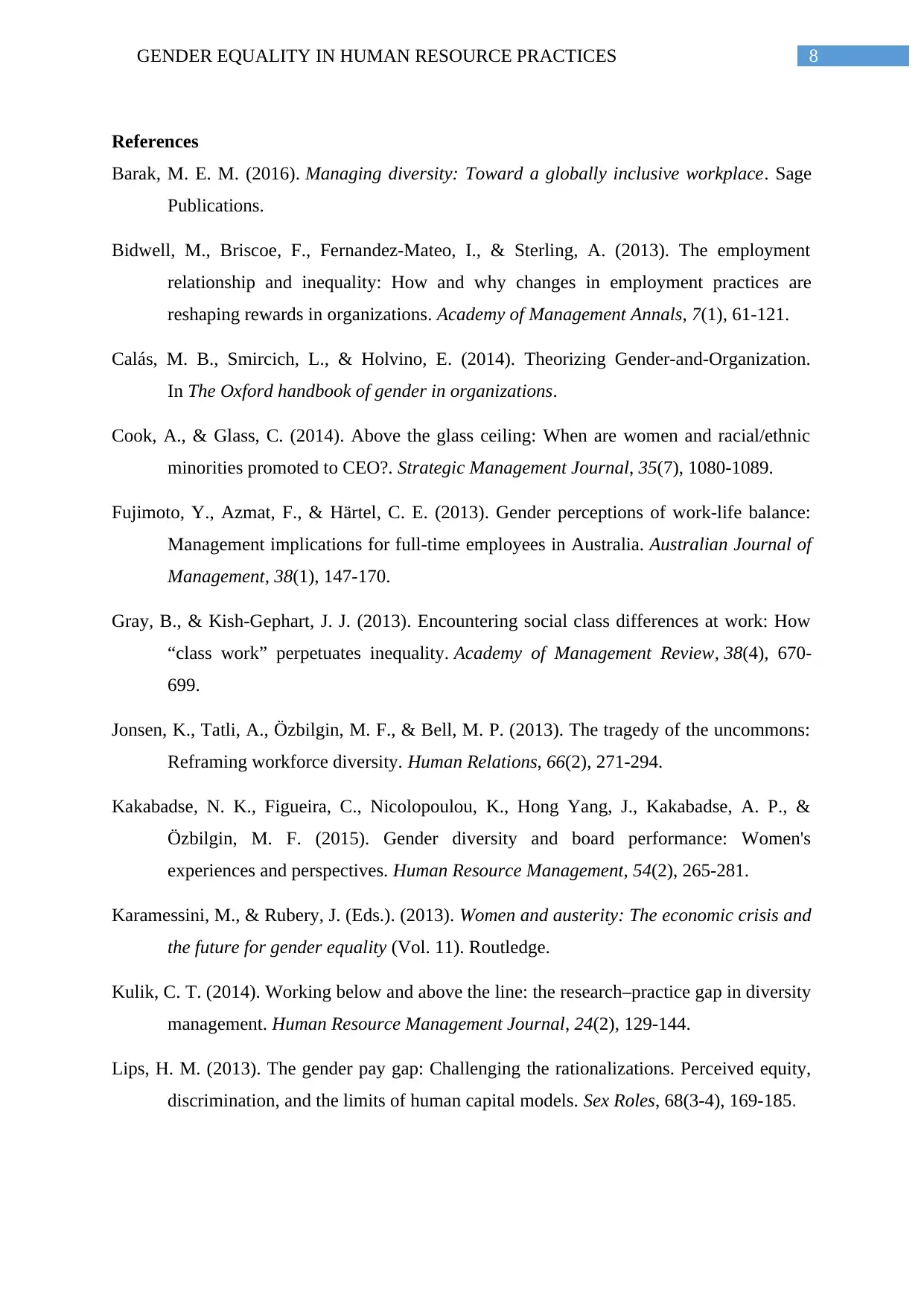
8GENDER EQUALITY IN HUMAN RESOURCE PRACTICES
References
Barak, M. E. M. (2016). Managing diversity: Toward a globally inclusive workplace. Sage
Publications.
Bidwell, M., Briscoe, F., Fernandez-Mateo, I., & Sterling, A. (2013). The employment
relationship and inequality: How and why changes in employment practices are
reshaping rewards in organizations. Academy of Management Annals, 7(1), 61-121.
Calás, M. B., Smircich, L., & Holvino, E. (2014). Theorizing Gender-and-Organization.
In The Oxford handbook of gender in organizations.
Cook, A., & Glass, C. (2014). Above the glass ceiling: When are women and racial/ethnic
minorities promoted to CEO?. Strategic Management Journal, 35(7), 1080-1089.
Fujimoto, Y., Azmat, F., & Härtel, C. E. (2013). Gender perceptions of work-life balance:
Management implications for full-time employees in Australia. Australian Journal of
Management, 38(1), 147-170.
Gray, B., & Kish-Gephart, J. J. (2013). Encountering social class differences at work: How
“class work” perpetuates inequality. Academy of Management Review, 38(4), 670-
699.
Jonsen, K., Tatli, A., Özbilgin, M. F., & Bell, M. P. (2013). The tragedy of the uncommons:
Reframing workforce diversity. Human Relations, 66(2), 271-294.
Kakabadse, N. K., Figueira, C., Nicolopoulou, K., Hong Yang, J., Kakabadse, A. P., &
Özbilgin, M. F. (2015). Gender diversity and board performance: Women's
experiences and perspectives. Human Resource Management, 54(2), 265-281.
Karamessini, M., & Rubery, J. (Eds.). (2013). Women and austerity: The economic crisis and
the future for gender equality (Vol. 11). Routledge.
Kulik, C. T. (2014). Working below and above the line: the research–practice gap in diversity
management. Human Resource Management Journal, 24(2), 129-144.
Lips, H. M. (2013). The gender pay gap: Challenging the rationalizations. Perceived equity,
discrimination, and the limits of human capital models. Sex Roles, 68(3-4), 169-185.
References
Barak, M. E. M. (2016). Managing diversity: Toward a globally inclusive workplace. Sage
Publications.
Bidwell, M., Briscoe, F., Fernandez-Mateo, I., & Sterling, A. (2013). The employment
relationship and inequality: How and why changes in employment practices are
reshaping rewards in organizations. Academy of Management Annals, 7(1), 61-121.
Calás, M. B., Smircich, L., & Holvino, E. (2014). Theorizing Gender-and-Organization.
In The Oxford handbook of gender in organizations.
Cook, A., & Glass, C. (2014). Above the glass ceiling: When are women and racial/ethnic
minorities promoted to CEO?. Strategic Management Journal, 35(7), 1080-1089.
Fujimoto, Y., Azmat, F., & Härtel, C. E. (2013). Gender perceptions of work-life balance:
Management implications for full-time employees in Australia. Australian Journal of
Management, 38(1), 147-170.
Gray, B., & Kish-Gephart, J. J. (2013). Encountering social class differences at work: How
“class work” perpetuates inequality. Academy of Management Review, 38(4), 670-
699.
Jonsen, K., Tatli, A., Özbilgin, M. F., & Bell, M. P. (2013). The tragedy of the uncommons:
Reframing workforce diversity. Human Relations, 66(2), 271-294.
Kakabadse, N. K., Figueira, C., Nicolopoulou, K., Hong Yang, J., Kakabadse, A. P., &
Özbilgin, M. F. (2015). Gender diversity and board performance: Women's
experiences and perspectives. Human Resource Management, 54(2), 265-281.
Karamessini, M., & Rubery, J. (Eds.). (2013). Women and austerity: The economic crisis and
the future for gender equality (Vol. 11). Routledge.
Kulik, C. T. (2014). Working below and above the line: the research–practice gap in diversity
management. Human Resource Management Journal, 24(2), 129-144.
Lips, H. M. (2013). The gender pay gap: Challenging the rationalizations. Perceived equity,
discrimination, and the limits of human capital models. Sex Roles, 68(3-4), 169-185.
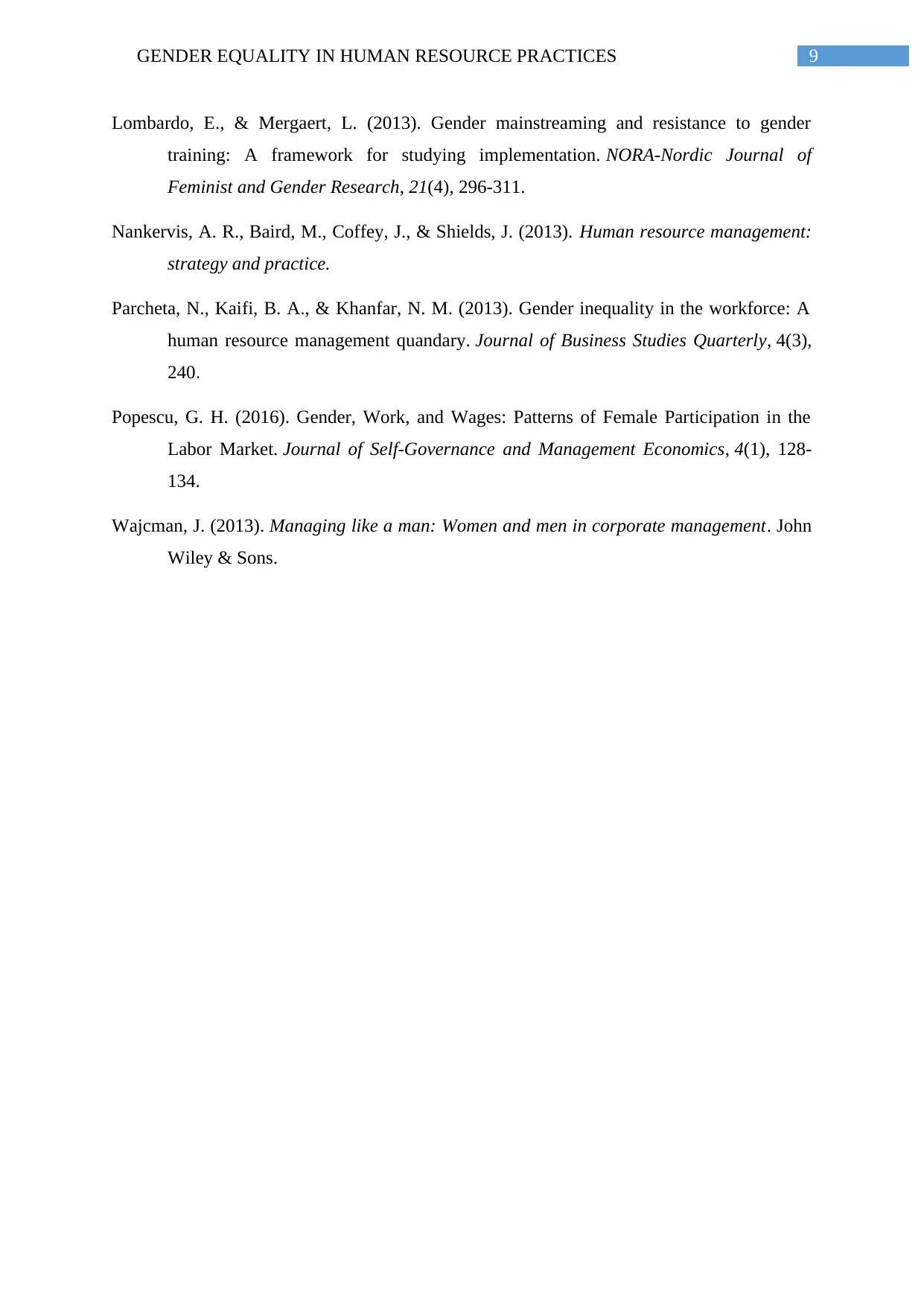
9GENDER EQUALITY IN HUMAN RESOURCE PRACTICES
Lombardo, E., & Mergaert, L. (2013). Gender mainstreaming and resistance to gender
training: A framework for studying implementation. NORA-Nordic Journal of
Feminist and Gender Research, 21(4), 296-311.
Nankervis, A. R., Baird, M., Coffey, J., & Shields, J. (2013). Human resource management:
strategy and practice.
Parcheta, N., Kaifi, B. A., & Khanfar, N. M. (2013). Gender inequality in the workforce: A
human resource management quandary. Journal of Business Studies Quarterly, 4(3),
240.
Popescu, G. H. (2016). Gender, Work, and Wages: Patterns of Female Participation in the
Labor Market. Journal of Self-Governance and Management Economics, 4(1), 128-
134.
Wajcman, J. (2013). Managing like a man: Women and men in corporate management. John
Wiley & Sons.
Lombardo, E., & Mergaert, L. (2013). Gender mainstreaming and resistance to gender
training: A framework for studying implementation. NORA-Nordic Journal of
Feminist and Gender Research, 21(4), 296-311.
Nankervis, A. R., Baird, M., Coffey, J., & Shields, J. (2013). Human resource management:
strategy and practice.
Parcheta, N., Kaifi, B. A., & Khanfar, N. M. (2013). Gender inequality in the workforce: A
human resource management quandary. Journal of Business Studies Quarterly, 4(3),
240.
Popescu, G. H. (2016). Gender, Work, and Wages: Patterns of Female Participation in the
Labor Market. Journal of Self-Governance and Management Economics, 4(1), 128-
134.
Wajcman, J. (2013). Managing like a man: Women and men in corporate management. John
Wiley & Sons.
1 out of 10
Related Documents
Your All-in-One AI-Powered Toolkit for Academic Success.
+13062052269
info@desklib.com
Available 24*7 on WhatsApp / Email
![[object Object]](/_next/static/media/star-bottom.7253800d.svg)
Unlock your academic potential
© 2024 | Zucol Services PVT LTD | All rights reserved.





